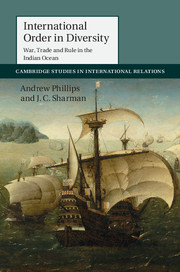Book contents
- Frontmatter
- Contents
- List of maps
- List of tables
- Acknowledgements
- Introduction
- 1 The puzzle of durable diversity in International Relations
- 2 The initial growth of diversity, 1500–1600
- 3 The expansion of diversity and competition under heteronomy, 1600–1650
- 4 The stabilization of diversity, 1600–1750
- 5 Reconfiguring diversity in the age of empire, 1750–1900
- Conclusion: Order in diversity
- Bibliography
- Index
- CAMBRIDGE STUDIES IN INTERNATIONAL RELATIONS
Conclusion: Order in diversity
Published online by Cambridge University Press: 05 May 2015
- Frontmatter
- Contents
- List of maps
- List of tables
- Acknowledgements
- Introduction
- 1 The puzzle of durable diversity in International Relations
- 2 The initial growth of diversity, 1500–1600
- 3 The expansion of diversity and competition under heteronomy, 1600–1650
- 4 The stabilization of diversity, 1600–1750
- 5 Reconfiguring diversity in the age of empire, 1750–1900
- Conclusion: Order in diversity
- Bibliography
- Index
- CAMBRIDGE STUDIES IN INTERNATIONAL RELATIONS
Summary
The period after the end of the Second World War saw a massive transfer of political authority from European colonial rulers to local political elites across the Indian Ocean. In line with broader global trends, the regional international system was transformed from one dominated by empires to one exclusively populated by sovereign states. Beginning in South Asia, the British Indian Empire became the new sovereign states of India and Pakistan, with Burma and Ceylon also receiving independence at this time. In South-East Asia, Dutch defeat by the Japanese in 1941–2, a post-war insurgency by nationalists, and the pressure of international opinion produced the new archipelagic state of Indonesia. The 1950s saw the violent expulsion of the French from mainland South-East Asia, together with the British withdrawal from what became Malaysia from 1957–63. After Lisbon refused to cede what it claimed was the metropolitan Portuguese territory of Goa, hastily evacuating the remains of St Francis Xavier and commanding the members of the garrison to die at their posts, Portuguese forces were overwhelmed by an Indian invasion in 1961. In the late 1960s the British government made it clear to the small sheikdoms of the Persian Gulf that it could no longer honour the 1892 treaty of protection, even after local rulers offered to pay the whole cost of British forces in the region, and so the United Arab Emirates, Qatar and Bahrain became sovereign states in the early 1970s. The first Europeans to shape the region's politics were almost the last to leave, with Portugal's presence at the eastern and western ends of the region lasting until the Carnation Revolution of 1974 sapped the government's will to continue the fight against local independence movements. Independence, but not peace, thus came to Mozambique, while East Timor exchanged one set of colonial masters for another with the brutal Indonesian invasion and occupation.
- Type
- Chapter
- Information
- International Order in DiversityWar, Trade and Rule in the Indian Ocean, pp. 202 - 224Publisher: Cambridge University PressPrint publication year: 2015



